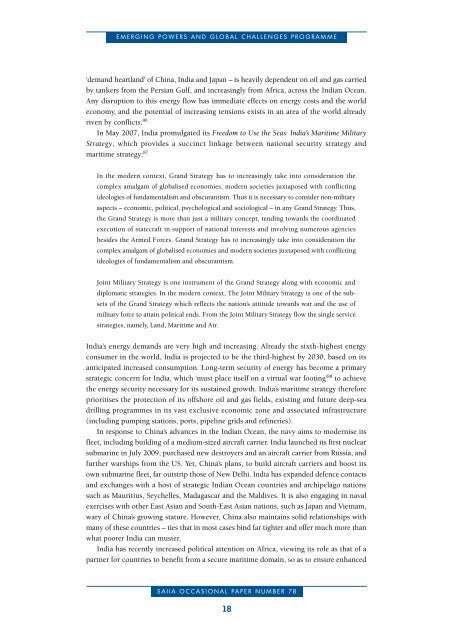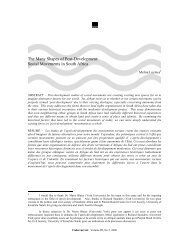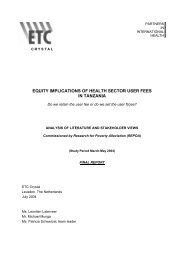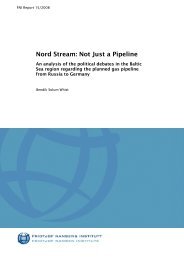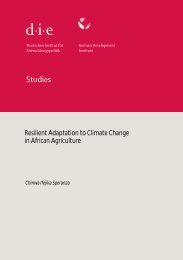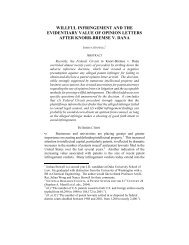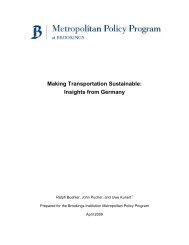Africa and the Geopolitics of the Indian Ocean
Africa and the Geopolitics of the Indian Ocean
Africa and the Geopolitics of the Indian Ocean
You also want an ePaper? Increase the reach of your titles
YUMPU automatically turns print PDFs into web optimized ePapers that Google loves.
EMERgINg POwERS ANd gLOBAL ChALLENgES PROgRAMME<br />
‘dem<strong>and</strong> heartl<strong>and</strong>’ <strong>of</strong> China, India <strong>and</strong> Japan – is heavily dependent on oil <strong>and</strong> gas carried<br />
by tankers from <strong>the</strong> Persian Gulf, <strong>and</strong> increasingly from <strong>Africa</strong>, across <strong>the</strong> <strong>Indian</strong> <strong>Ocean</strong>.<br />
Any disruption to this energy flow has immediate effects on energy costs <strong>and</strong> <strong>the</strong> world<br />
economy, <strong>and</strong> <strong>the</strong> potential <strong>of</strong> increasing tensions exists in an area <strong>of</strong> <strong>the</strong> world already<br />
riven by conflicts. 86<br />
In May 2007, India promulgated its Freedom to Use <strong>the</strong> Seas: India’s Maritime Military<br />
Strategy, which provides a succinct linkage between national security strategy <strong>and</strong><br />
maritime strategy: 87<br />
In <strong>the</strong> modern context, Gr<strong>and</strong> Strategy has to increasingly take into consideration <strong>the</strong><br />
complex amalgam <strong>of</strong> globalised economies, modern societies juxtaposed with conflicting<br />
ideologies <strong>of</strong> fundamentalism <strong>and</strong> obscurantism. Thus it is necessary to consider non-military<br />
aspects – economic, political, psychological <strong>and</strong> sociological – in any Gr<strong>and</strong> Strategy. Thus,<br />
<strong>the</strong> Gr<strong>and</strong> Strategy is more than just a military concept, tending towards <strong>the</strong> coordinated<br />
execution <strong>of</strong> statecraft in support <strong>of</strong> national interests <strong>and</strong> involving numerous agencies<br />
besides <strong>the</strong> Armed Forces. Gr<strong>and</strong> Strategy has to increasingly take into consideration <strong>the</strong><br />
complex amalgam <strong>of</strong> globalised economies <strong>and</strong> modern societies juxtaposed with conflicting<br />
ideologies <strong>of</strong> fundamentalism <strong>and</strong> obscurantism.<br />
Joint Military Strategy is one instrument <strong>of</strong> <strong>the</strong> Gr<strong>and</strong> Strategy along with economic <strong>and</strong><br />
diplomatic strategies. In <strong>the</strong> modern context, The Joint Military Strategy is one <strong>of</strong> <strong>the</strong> subsets<br />
<strong>of</strong> <strong>the</strong> Gr<strong>and</strong> Strategy which reflects <strong>the</strong> nation’s attitude towards war <strong>and</strong> <strong>the</strong> use <strong>of</strong><br />
military force to attain political ends. From <strong>the</strong> Joint Military Strategy flow <strong>the</strong> single service<br />
strategies, namely, L<strong>and</strong>, Maritime <strong>and</strong> Air.<br />
India’s energy dem<strong>and</strong>s are very high <strong>and</strong> increasing. Already <strong>the</strong> sixth-highest energy<br />
consumer in <strong>the</strong> world, India is projected to be <strong>the</strong> third-highest by 2030, based on its<br />
anticipated increased consumption. Long-term security <strong>of</strong> energy has become a primary<br />
strategic concern for India, which ‘must place itself on a virtual war footing’ 88 to achieve<br />
<strong>the</strong> energy security necessary for its sustained growth. India’s maritime strategy <strong>the</strong>refore<br />
prioritises <strong>the</strong> protection <strong>of</strong> its <strong>of</strong>fshore oil <strong>and</strong> gas fields, existing <strong>and</strong> future deep-sea<br />
drilling programmes in its vast exclusive economic zone <strong>and</strong> associated infrastructure<br />
(including pumping stations, ports, pipeline grids <strong>and</strong> refineries).<br />
In response to China’s advances in <strong>the</strong> <strong>Indian</strong> <strong>Ocean</strong>, <strong>the</strong> navy aims to modernise its<br />
fleet, including building <strong>of</strong> a medium-sized aircraft carrier. India launched its first nuclear<br />
submarine in July 2009, purchased new destroyers <strong>and</strong> an aircraft carrier from Russia, <strong>and</strong><br />
fur<strong>the</strong>r warships from <strong>the</strong> US. Yet, China’s plans, to build aircraft carriers <strong>and</strong> boost its<br />
own submarine fleet, far outstrip those <strong>of</strong> New Delhi. India has exp<strong>and</strong>ed defence contacts<br />
<strong>and</strong> exchanges with a host <strong>of</strong> strategic <strong>Indian</strong> <strong>Ocean</strong> countries <strong>and</strong> archipelago nations<br />
such as Mauritius, Seychelles, Madagascar <strong>and</strong> <strong>the</strong> Maldives. It is also engaging in naval<br />
exercises with o<strong>the</strong>r East Asian <strong>and</strong> South-East Asian nations, such as Japan <strong>and</strong> Vietnam,<br />
wary <strong>of</strong> China’s growing stature. However, China also maintains solid relationships with<br />
many <strong>of</strong> <strong>the</strong>se countries – ties that in most cases bind far tighter <strong>and</strong> <strong>of</strong>fer much more than<br />
what poorer India can muster.<br />
India has recently increased political attention on <strong>Africa</strong>, viewing its role as that <strong>of</strong> a<br />
partner for countries to benefit from a secure maritime domain, so as to ensure enhanced<br />
SAIIA OCCASIONAL PAPER NUMBER 78<br />
18


